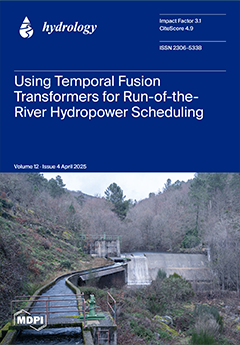Groundwater is one of the major sources of freshwater supply for drinking and domestic purposes. This study evaluates the hydrogeochemical processes, groundwater quality for human consumption, associated health risks from fluoride F
− and nitrate (NO
3−), and sources of dissolved
[...] Read more.
Groundwater is one of the major sources of freshwater supply for drinking and domestic purposes. This study evaluates the hydrogeochemical processes, groundwater quality for human consumption, associated health risks from fluoride F
− and nitrate (NO
3−), and sources of dissolved solutes in a highland watershed in northern Pakistan. Groundwater samples (
n = 51) were gathered and analyzed for a range of physicochemical parameters. To evaluate contamination, indices such as the nitrate pollution index (NPI) and fluoride pollution index (FPI) were applied, along with a composite groundwater pollution index to assess overall water quality. The findings revealed that total dissolved solid, turbidity, F
−, and K
+ levels exceeded health-based thresholds in 20%, 1%, 4%, and 2% of samples, respectively. Among the water sources, handpumps were identified as the most contaminated. According to the NPI and composite index, 96% and 92% of the samples did not show significant contamination, respectively. However, the FPI results highlighted that 59% of the samples exhibited low F
− pollution, while 41% fell under medium pollution levels. While NO
3− ingestion posed no notable health risks,
exposure presented significant concerns, with 58.8% of the samples posing risks, particularly for children. The dominant hydrochemical facies were Ca-Mg-HCO
3, with the main influence on water chemistry by rock-water interactions and reverse ion exchange processes.
Full article





